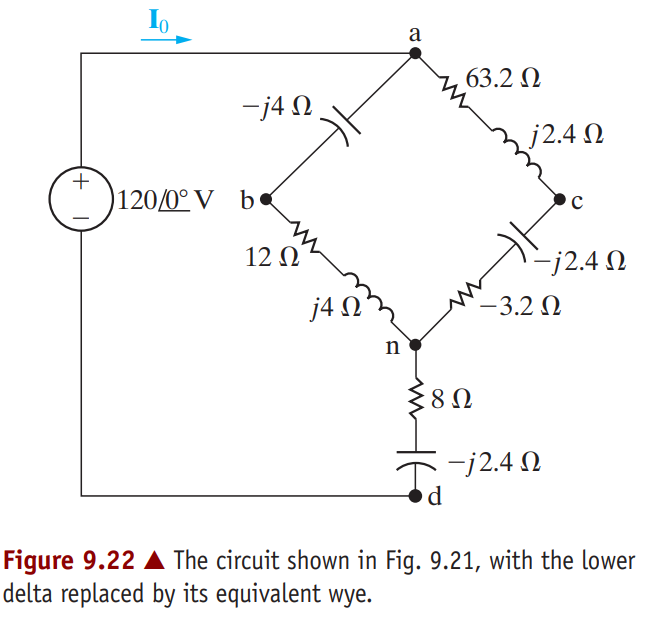Use a Δ-to-Y impedance transformation to find\pmb{I}_{0},\pmb{I}_{1},\pmb{I}_{2} ,\pmb{I}_{3},\pmb{I}_{4},\pmb{I}_{5},\pmb{V}_{1},and \pmb{V}_{2} in the circuit in Fig. 9.21.
Question 9.8: Use a Δ-to-Y impedance transformation to find I0,I1,I2,I3,I4...

The Blue Check Mark means that this solution has been answered and checked by an expert. This guarantees that the final answer is accurate.
Learn more on how we answer questions.
Learn more on how we answer questions.
First note that the circuit is not amenable to series or parallel simplification as it now stands. A Δ -to-Y impedance transformation allows us to solve for all the branch currents without resorting to either the node-voltage or the mesh-current method. If we replace either the upper delta (abc) or the lower delta (bcd) with its Y equivalent, we can further simplify the resulting circuit by series-parallel combinations. In deciding which delta to replace, the sum of the impedances around each delta is worth checking because this quantity forms the denominator for the equivalent Y impedances. The sum around the lower delta is so we choose to eliminate it from the circuit. The Y impedance connecting to terminal b is
Z_{1} =\frac{(20 + j60)(10)}{30 + j40} = 12 + j4Ω,
the Y impedance connecting to terminal c is
Z_{2} =\frac{10( – j20)(10)}{30 + j40} = -3.2 – j 2.4 Ω,
and the Y impedance connecting to terminal d is
Z_{3} =\frac{(20 + j60)( – j20)}{30 + j40} =8 – j 24 Ω,
Inserting the Y-equivalent impedances into the circuit, we get the circuit shown in Fig 9.22, which we can now simplify by series-parallel reductions. The impedence of the abn branch is
Z_{abn} = 12+ j4- j4=12Ω,
and the impedance of the acn branch is
Z_{acn} = 63.2 + j 2.4 – j 2.4 – 3.2 = 60Ω.
Note that the abn branch is in parallel with the acn branch. Therefore we may replace these two branches with a single branch having an impedance of
Z_{an} =\frac{(60)( 12)}{72} =10 Ω,
Combining this 10 Ω resistor with the impedance between n and d reduces the circuit shown in Fig. 9.22 to the one shown in Fig. 9.23. From the latter circuit,
\pmb{I}_{0} =\frac{120 \angle 0^{°}}{18 – j 24} = 4 \angle 53.13^{°}= 2.4 + j 3.2 A.
Once we know\pmb{I}_{0} we can work back through the equivalent circuits to find the branch currents in the original circuit. We begin by noting that \pmb{I}_{0} is the current in the branch nd of Fig. 9.22. Therefore
\pmb{V}_{nd} = (8 – j 24)\pmb{I}_{0} = 96 – j 32 V.
We may now calculate the voltage \pmb{V}_{an} because
\pmb{V}=\pmb{V}_{an}+\pmb{V}_{nd} .
and both V and \pmb{V}_{nd} are known. Thus
\pmb{V}_{an}= 120 – 96 + j 32 = 24 + j 32 V.
We now compute the branch currents \pmb{I}_{abn} and \pmb{I}_{acn} :
\pmb{I}_{abn} =\frac{24+j32}{12} =2 + j\frac{8}{3}A,
\pmb{I}_{acn} =\frac{24+j32}{60} =\frac{4}{10} + j\frac{8}{15}A.
In terms of the branch currents defined in Fig. 9.21,
\pmb{I}_{1} =\pmb{I}_{abn}=2 + j\frac{8}{3}A,
\pmb{I}_{2} =\pmb{I}_{acn} =\frac{4}{10} + j\frac{8}{15}A.
We check the calculations of \pmb{I}_{1} and \pmb{I}_{2} by noting that
\pmb{I}_{1} + \pmb{I}_{2} = 2.4 + j 3.2 = \pmb{I}_{0}.
To find the branch currents \pmb{I}_{3},\pmb{I}_{4},and \pmb{I}_{5} we must first calculate the voltages \pmb{V}_{1}and \pmb{V}_{2} Refering to Fig. 9.21, we note that
\pmb{V}_{1} =120 \angle 0^{°}- (-j4) \pmb{I}_{1}=\frac{328}{3} + j8 V, .
\pmb{V}_{2} =120 \angle 0^{°}- (63.2 + j 2.4) \pmb{I}_{2}= 96 – j\frac{104}{3} V.
We now calculate the branch currents \pmb{I}_{3},\pmb{I}_{4},and \pmb{I}_{5} :
\pmb{I}_{3}=\frac{V_{1}-V_{2}}{10}=\frac{4}{3}+ j\frac{12.8}{3}A,
\pmb{I}_{4}=\frac{V_{1}}{20+j60}=\frac{2}{3}- j1.6A,
\pmb{I}_{4}=\frac{V_{2}}{-j20}=\frac{26}{15}+ j4.8 A.
We check the calculations by noting that
\pmb{I}_{4}+ \pmb{I}_{5}=\frac{2}{3}+\frac{26}{15}- j1.6+ j4.8=2.4 + j 3.2 = \pmb{I}_{0},\pmb{I}_{3}+ \pmb{I}_{4}=\frac{4}{3}+\frac{2}{3}+ j\frac{12.8}{3}- j1.6=2 + j\frac{8}{3}= \pmb{I}_{1},
\pmb{I}_{3}+ \pmb{I}_{2}=\frac{4}{3}+\frac{4}{10} + j\frac{12.8}{3} + j\frac{8}{15}=\frac{26}{15}+ j4.8 = \pmb{I}_{5} .


Related Answered Questions
a) We begin by constructing the phasor domain equi...
By Kirchhoff’s current law, the sum of the current...
We begin by assuming zero capacitance across the l...
We can replace the series combination of the volta...
We first determine the Thévenin equivalent voltage...
We can describe the circuit in terms of two node v...
The circuit has two meshes and a dependent voltage...
a) Figure 9.39 shows the frequency-domain equivale...